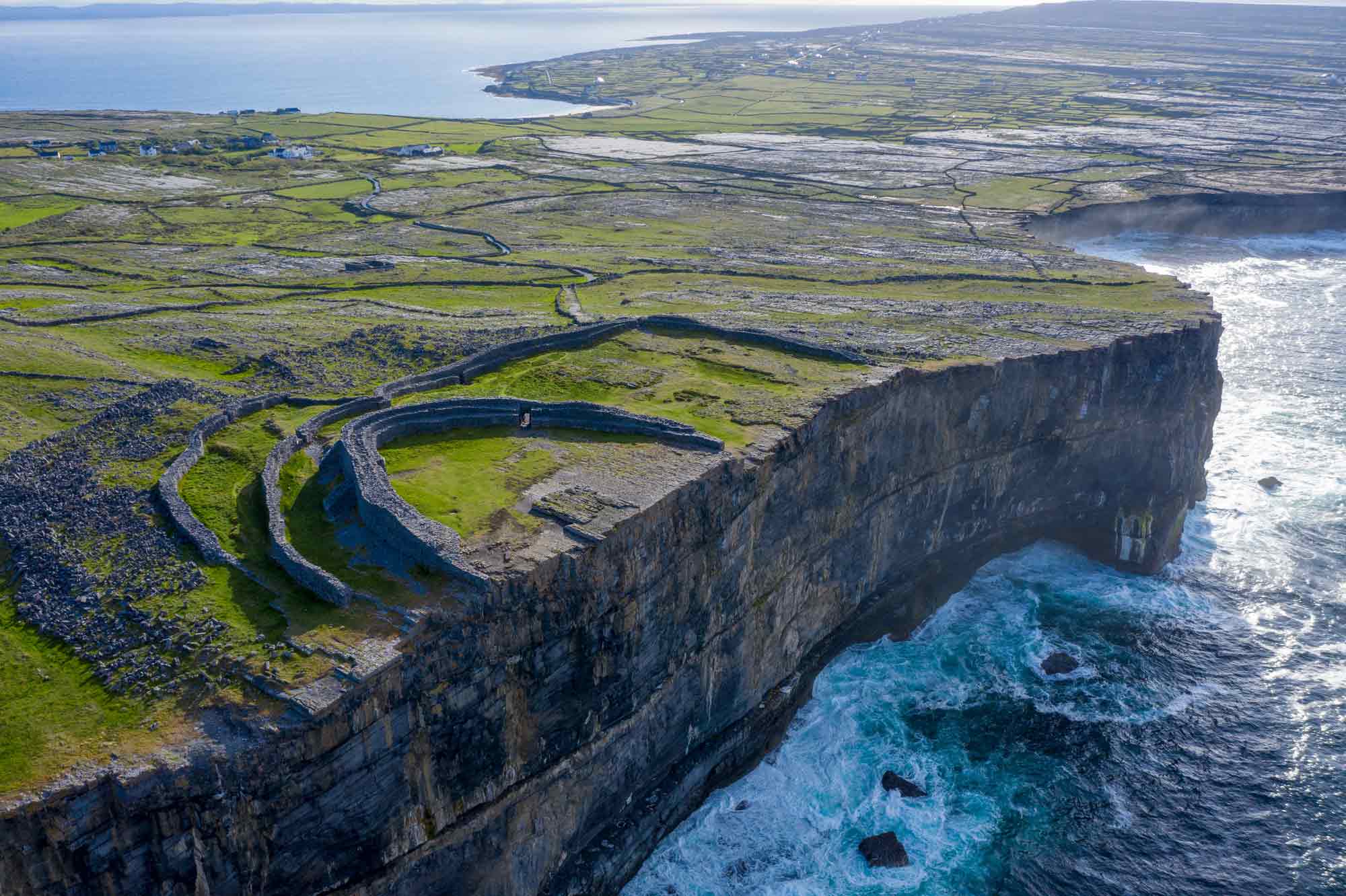Summary
Exploring Dun Aonghasa’s Ancient Mystique
Perched on the edge of a dramatic cliff on Inis Mór, Dun Aonghasa offers a window into ancient Ireland. This prehistoric hill fort dates back to the Bronze Age. It draws visitors into a time when tribal leaders fortified their domains with imposing stone walls. The site’s semi-circular structure overlooks the Atlantic, offering both defensive strength and breathtaking views. Archaeologists believe Dun Aonghasa served both as a fortress and a ceremonial gathering place. Today, it stands as a testament to the resilience and ingenuity of early Irish society.
Get your dose of History via Email
Uncovering the Architectural Secrets
The complex engineering of Dun Aonghasa’s multiple walls and terraces is a marvel. It reveals much about the society that constructed it over millennia. The inner enclosure, with its Chevaux-de-frise—a spiky stone defense system—shows advanced defensive strategies. Researchers have delved into the layers of history here, uncovering artifacts that hint at daily life and warfare in ancient times. Restoration efforts have protected the site, allowing modern visitors to step back in time as they navigate through the remains of this once-powerful stronghold.
Connecting with Celtic Heritage
More than just a relic, Dun Aonghasa is a profound cultural symbol for Celtic heritage. It connects visitors to Ireland’s mystical past, where legends of druids and ancient kings still resonate. The fort’s setting on the wild Aran Islands enriches the experience, with traditional Irish culture flourishing within these rugged landscapes. By exploring Dun Aonghasa, one gains a deeper appreciation for the natural beauty and historical depth that Ireland offers, making it a quintessential experience for anyone seeking to understand the soul of this enchanting country.
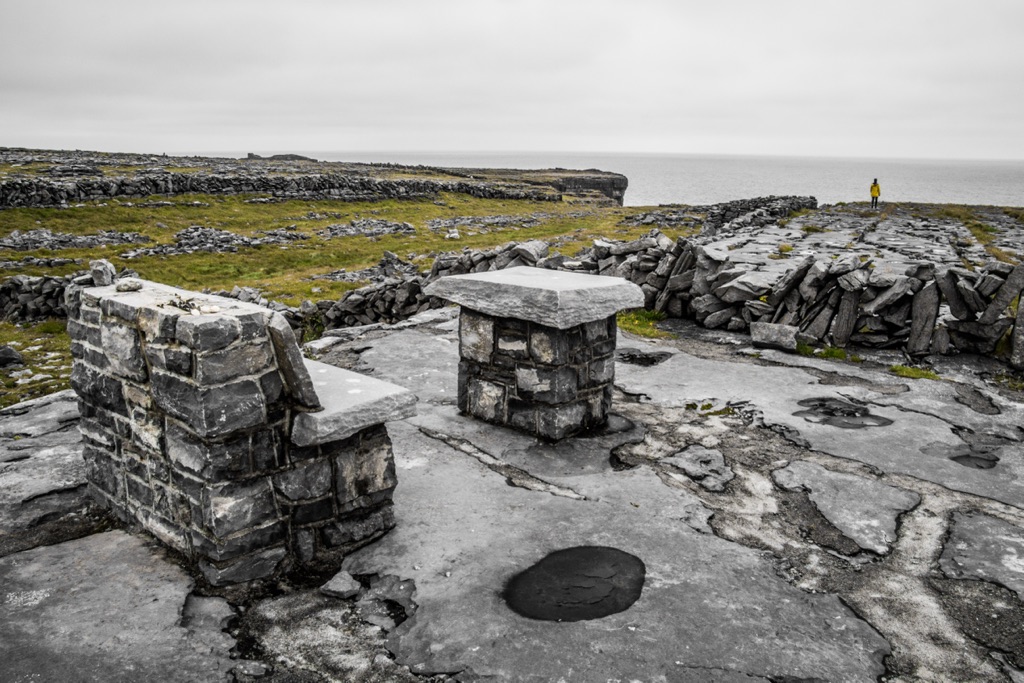
Historical Background of Dun Aonghasa
A Window into Prehistoric Fortification
Inis Mór, the largest of the Aran Islands, is home to one of the most impressive prehistoric sites in Europe—Dun Aonghasa. This hill fort stands majestically atop a 100-meter high cliff, offering stunning views and insight into ancient Irish craftsmanship. Experts date the fort to the late Bronze Age, around 1100 BC, suggesting continuous human activity in this area for more than three thousand years. Dun Aonghasa’s size and design reflect the importance of defense in a tumultuous period of Ireland’s history, as well as the social and political complexities of those ancient communities.
The Enigmatic Structures Unveiled
The fort consists of four concentric stone walls and the interior features a complex of chambers, platforms, and a central enclosure. Intriguingly, outside the main wall lies a band of jagged, upright stones known as Chevaux-de-frise. This defensive structure was not only a protective measure but also a striking statement of power to anyone approaching the fort. The walls and barriers, crafted with the local limestone, have withstood the test of time, showcasing the builders’ advanced understanding of stonework and their environment.
Echoes of Celtic Rituals and Daily Life
While primarily a defensive stronghold, Dun Aonghasa likely had a significant role in religious and ceremonial practices. Excavations have unearthed various artifacts such as tools, weapons, and pottery, shedding light on the daily life within the fort. Characteristic of a prominent settlement, it is thought that Dun Aonghasa was a focal point for festivals and rituals, perhaps led by the Druids, which would have played a vital role in solidifying community ties and cultural identity.
The Preservation Efforts of Dun Aonghasa
In modern times, Dun Aonghasa has become a symbol of Irish heritage and perseverance. The preservation and archaeological exploration of the site have been essential in understanding Ireland’s past. These efforts ensure that the fort remains intact not only as a tourist destination but also as a historical archive that provides invaluable insight into Ireland’s ancestral roots and the ingenuity of its people.
A Living Monument of Irish History
Today, Dun Aonghasa stands as a testament to Ireland’s rich and enduring history. As a popular attraction, it allows visitors from around the world to connect with Ireland’s ancient past. The experience of visiting this hill fort goes beyond mere sightseeing; it is a journey through time that captures the spirit of the Irish people and their storied past. Dun Aonghasa continues to guard the mysteries of an age-old civilization, offering inspiration and awe to all who walk its ancient grounds.
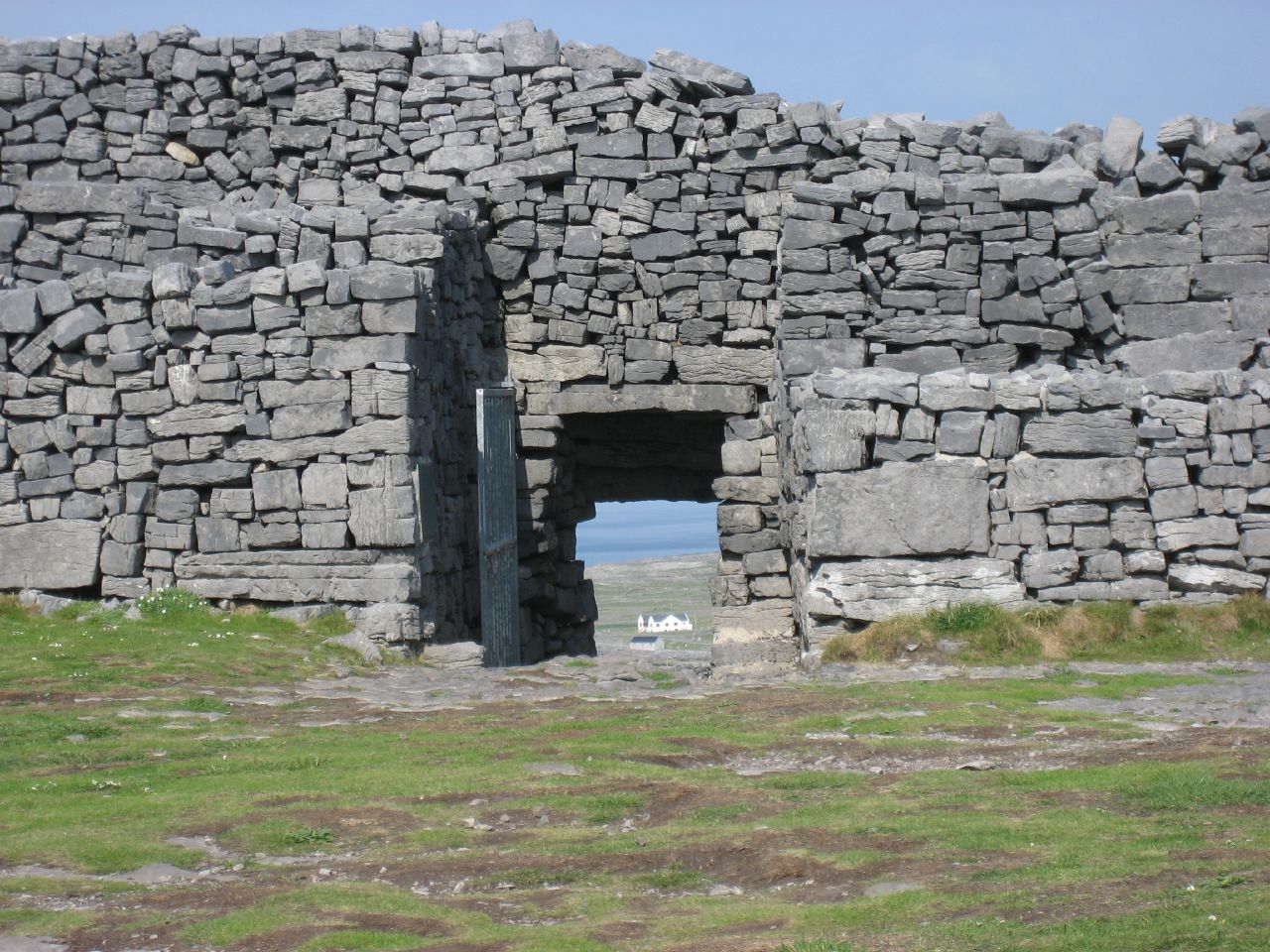
The Discovery of Dun Aonghasa
An Unexpected Find on Inis Mór
The revelation of Dun Aonghasa’s historical significance unfolded gradually, much like the mist lifting from the hills of the Aran Islands. Though the site was known locally for generations, it was not until the 19th century that it captured broader attention. Antiquarians and historians, intrigued by oral histories and the unique landscape, began to explore its origins in earnest. The result was a growing recognition of Dun Aonghasa’s true importance, an ancient fort at the edge of the Atlantic.
The Pivotal Role of George Petrie
George Petrie, a notable geologist and antiquarian, played a seminal role in the site’s historical resonance. Through his endeavors in the 1850s, Dun Aonghasa’s profile rose from a local landmark to a national treasure. Petrie’s detailed sketches and descriptions brought a level of scholarly attention that had been absent before, sparking interest that has since never waned. His work paved the way for future excavations that would unravel the rich tapestry of Dun Aonghasa’s past.
A Century of Archaeological Insight
Archaeological interest in Dun Aonghasa surged with the turn of the 20th century. It was during this time that the fort’s complex structure began to be uncovered in detailed excavations. These efforts, spearheaded by the passion of archaeologists like R.A.S. Macalister, revealed the sophisticated nature of the fortifications and the everyday objects that whispered tales of a long-gone era. The work at the site illuminated the fort’s historical significance and cemented its status as a monument of human ingenuity.
Worldwide Recognition
The discoveries made at Dun Aonghasa have been crucial in solidifying its place as a UNESCO World Heritage Site candidate. This recognition has not only spotlighted the historical and cultural significance of the site but also emphasized the imperative to preserve it for generations to come. The spotlight turned toward Dun Aonghasa has ensured that this ancient stronghold remains at the forefront of Irish heritage conservation efforts, serving as an icon of prehistoric life on the island.
Continuing the Legacy
The story of Dun Aonghasa is far from over. As new archaeological methods emerge and our understanding of the past deepens, the site continues to unveil hidden aspects of its storied existence. Each visitor today walks in the footsteps of those ancient inhabitants, explorers, and scholars who have all been captivated by the mystery of this windswept fortress. Dun Aonghasa remains not only a testament to human history but also a living symbol of the quest for knowledge about our shared past.
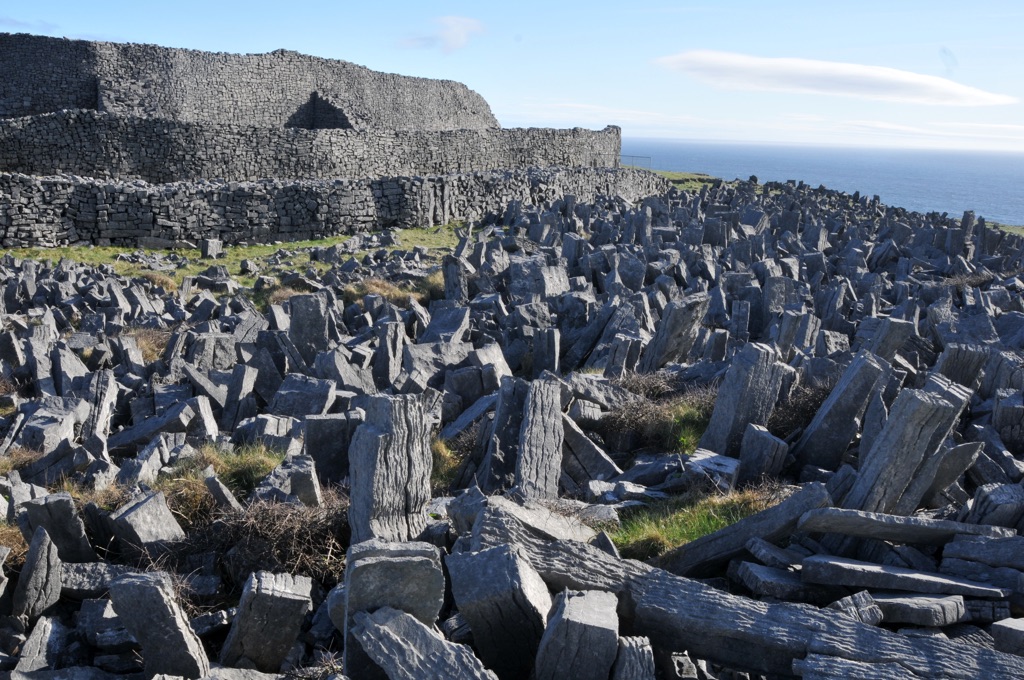
Cultural Significance, Dating methods, Theories, and Interpretations
The Cultural Heart of Prehistoric Ireland
At the cliff’s edge of Inis Mór stands Dun Aonghasa, a fort that resonates with cultural importance. Irish legends speak of the fort as a stronghold of the kings, a central hub in a network of similar hillforts. It has been a place of gathering, defense and a representation of power throughout centuries. Today, it serves as a symbol of Irish identity and historical pride. The lore and history that surround it, from mythology to its historical use in Gaelic society, embody the resilience and spirit of the Irish.
Peeling Back the Layers of the Past
Dating Dun Aonghasa has been a challenge but one that has illuminated its expansive history. Through radiocarbon dating, experts have traced its earliest elements back to the late Bronze Age, about 1100 BC. Further studies of the site’s masonry techniques and tool marks have provided insights into its construction phases throughout the Iron Age. These methods unravel the story of Dun Aonghasa’s development, revealing how each generation adapted and fortified the structure, adding to its grandeur and complexity.
Unraveling the Fort’s Purpose
Theories about Dun Aonghasa’s original function abound. Some scholars suggest it was a purely defensive structure, while others argue its layout indicates a significant religious or social role. The presence of the Chevaux-de-frise and the fort’s strategic position support the defensive theory, yet the discovery of human remains and artifacts point to ceremonial use. Interpretations continue to evolve, painting a picture of a dynamic and multifaceted community hub.
Interpretive Journeys Through Archaeology
Interpretations of Dun Aonghasa’s significance have shifted over the years, shaped by ongoing archaeological discoveries. Each excavation brings new theories, from the fort being an ancient astronomical observatory to a place of druidic power. The constant reinterpretation signifies Dun Aonghasa as a living site of heritage, one that invites current generations to engage with their ancestors’ pursuits, battles, and beliefs.
Crossroad of Past and Present
Dun Aonghasa’s lore and mysteries continue to enthral both scholars and visitors. It is a cultural bridge to the past and a custodian of millennia of Irish history. As explorations and studies progress, Dun Aonghasa reminds us that history is not static but an ongoing dialogue between the past and those of us in the present tasked with its stewardship.
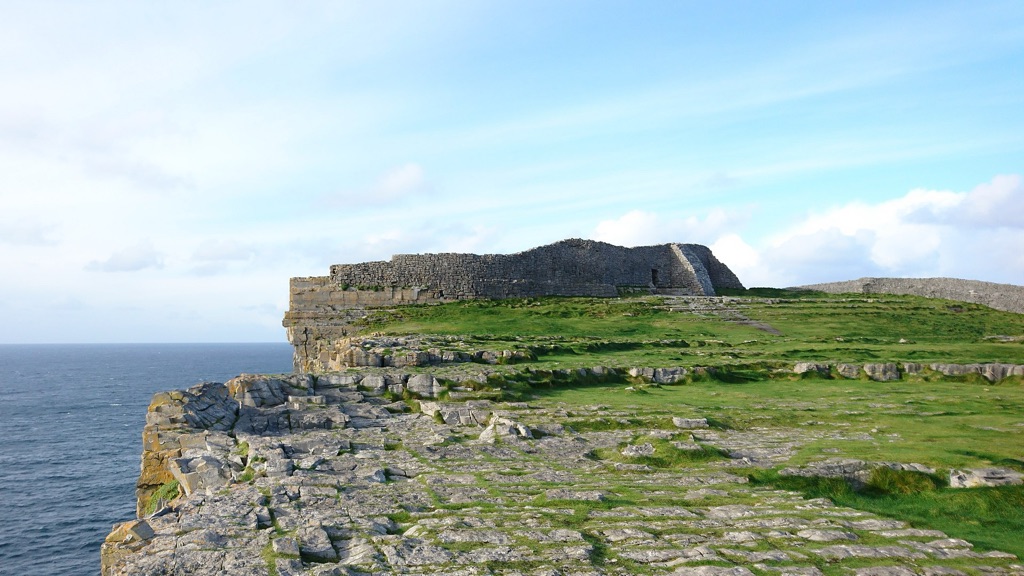
Conclusion and Sources
The exploration of Dun Aonghasa uncovers the complexity of ancient Irish history and its enduring influence on contemporary Irish culture. From the archaeological discoveries to the preservation efforts, each facet of the investigation into this prehistoric fort has paved the way for a better understanding of the people who built it. The fort’s cultural and historical significance is unquestionable. It is a priceless window into the past and an emblem of human achievement. As the site continues to be studied, its mysteries and stories will further unfold, enhancing our collective knowledge of early Irish society and its sophisticated traditions of fortification and community life.
O’Kelly, M. J. (1989). Early Ireland: An introduction to Irish prehistory. Cambridge University Press.
Waddell, J. (1998). The prehistoric archaeology of Ireland. Galway University Press.
Aran Islands Conservation Plan (2007). Heritage Council Ireland. Retrieved from http://www.heritagecouncil.ie.
Raftery, B. (1994). Pagan Celtic Ireland: The enigma of the Irish Iron Age. Thames and Hudson.
Harbison, P. (1976). Guide to the National Monuments in the Republic of Ireland. Gill and Macmillan.

